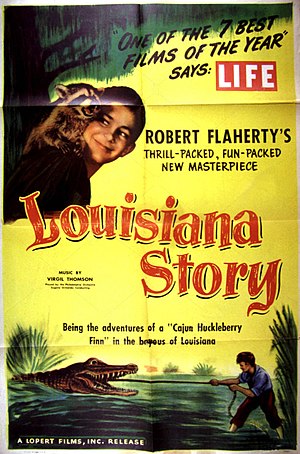Louisiana Story
Jump to navigation
Jump to search
| Louisiana Story | ||||||||||||||||||||
|---|---|---|---|---|---|---|---|---|---|---|---|---|---|---|---|---|---|---|---|---|
This film has been preserved in the National Film Registry in 1994.
| ||||||||||||||||||||
 | ||||||||||||||||||||
|
Louisiana Story is a 1948 American black-and-white drama film directed by Robert J. Flaherty. While it has been historically represented as a documentary film, the film's events and characters are fictional and the film was commissioned by the Standard Oil Company to promote its drilling ventures in the Louisiana bayous.
Why It Rocks
- Similar to Robert Flaherty's previous films, Nanook of the North, Moana, and Man of Aran, this film is a portrait of an isolated community: in this case it's about the Cajans of the Louisiana bayous.
- Roy Stryker, manager of public relations for Standard Oil of New Jersey, went to Flaherty about making a film for the company. He specifically wanted a "permanent artistic record of the contribution which the oil industry has made to civilization" that would "present the story of oil with the dignity, epic sweep it deserves." The story was told from the perspective of a single family.
- Flaherty's widowed wife resisted attempts to call the film a "documentary", referring to it as an autobiography or a fantasy of her husband's early life on the mining frontiers of Michigan. It's less of a documentary than some of Flathery's earlier films, and yet he made everything seem real, down to having out of focus shots, the camera moving and amateurish acting -- especially considering the director didn't shoot a real family, but rather one assembled from local inhabitants.
- This film was likely the first feature shot on an Arriflex 35mm camera, which cinematographer Richard Leacock used while filming in Louisiana. In the extended nature sequences, there's a visual style of almost supernatural beauty, a serene growing version of a nature filled with mortal danger.
- The film marks the first time Flaherty tried to incorporate sound into how he intended to shoot his story.
- There's a stunning opening passage -- a ten-minute scene where Boudreaux's character drifts through a lush buyou landscape on his pirogue.
- The film's sound design was complied from live sound recorded on site onto acetate disks. It was broken into three sections: Cajun folk music; "scenery" music inspired by Meldelssohn, Debussy, and other classical composers; and "noise" (such as a nine- minute oil derrick sequence.
The Only Bad Quality
- As previously mentioned, the acting can be amateurish at times, though this likely intentional for authenticity.